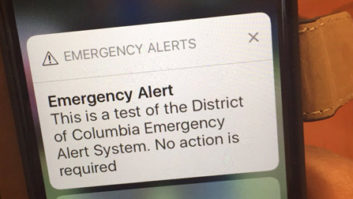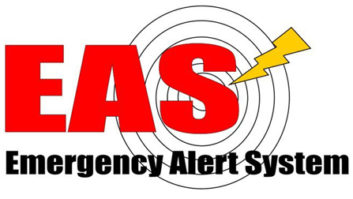 The nationwide test of the Emergency Alert System in October produced much better percentages for both receipt and retransmission than a test in 2021, according to the FCC. But issues still remain. The test also revealed that the performance of EAS in several U.S. territories was significantly worse than in the states.
The nationwide test of the Emergency Alert System in October produced much better percentages for both receipt and retransmission than a test in 2021, according to the FCC. But issues still remain. The test also revealed that the performance of EAS in several U.S. territories was significantly worse than in the states.
The commission’s Public Safety and Homeland Security Bureau issued its report on the nationwide EAS test and the simultaneous test of Wireless Emergency Alerts.
This was the seventh nationwide EAS test; the first was held in 2011. The large majority of EAS participants, including radio stations, reported successful receipt and retransmission.
“The test demonstrated that the national EAS distribution architecture is largely effective as designed,” the bureau wrote, though it “also shed light on operational readiness failures that prevented some EAS participants to receive and/or retransmit the test alert.”
The test message was received by 96.6% of EAS participants, up from 89.3% two years prior. The overall retransmission success rate was 93.6%, up from 87.1%.
The bureau said that this “significant” improvement was likely due to initiation of the 2023 test alert via Common Alerting Protocol, which added resiliency, compared to the 2021 test, which was strictly done over the air.
But that still means that more than 6% of EAS participants failed to retransmit the alert and that more than 4% reported some kind of equipment-related complication during retransmission. “It is essential that the entire public be able to successfully receive alerts in order to take protective action during emergencies,” the bureau wrote.
Outdated software
Where problems did occur, they involved equipment configuration issues, performance issues, audio quality issues, alerting source issues and clock errors.
“While test participants reported less than one-third as many performance complications as compared to 2021,” the bureau continued, “more test participants reported equipment configuration issues and equipment failures.” Outdated software was a notable issue.
“At the time of the test, approximately 23% of EAS equipment units representing over 4,500 EAS participants, were either using outdated software or were using equipment that no longer supported regular software updates.” Not surprisingly, equipment with software that is no longer supported had the lowest receipt and retransmission rates, 90% and 85%, respectively.
Of 72 National Public Warning System (Primary Entry Point) stations, two experienced technical issues receiving and retransmitting the alert, a decrease from seven of 76 NPWS stations in 2021 (approximately 9%).
These stations failed to receive the CAP alert via IPAWS as a result of internet issues. One specifically cited that their broadband internet service provider was experiencing an outage, while the other cited that the internet was “very slow.” These stations did not successfully receive the nationwide alert from the over-the-air sources that they monitored.
“As a practical matter, one way for EAS participants to reduce complications due to failure to receive the test alert, such as the complications discussed above, is to ensure that they monitor several independent sources of alerts,” the bureau wrote. “We also recommend that stations located far from NPWS stations consider the viability, technically and otherwise, of satellite sources of the broadcast alert.”
The test results suggest that EAS is far less reliable in U.S. territories.
Five of the six poorest-performing geographic regions were the Northern Mariana Islands (20.0% retransmission success), Guam (33.3%), American Samoa (66.7%), the U.S. Virgin Islands (88.9%) and Puerto Rico (89.7%).
The bureau noted that these territories “have been plagued by multiple tropical storms and typhoons in recent years including Super Typhoon Mawar affecting Guam and the Northern Mariana Islands in late May 2023, and Hurricane Fiona affecting Puerto Rico and the U.S. Virgin Islands and Puerto in September 2022.” It recommended that its staff engage with EAS participants there about this situation and work with the local emergency communications committees, if necessary helping to reinvigorate the SECCs and pursue enforcement actions, to ensure that EAS is effective.
On the Wireless Emergency Alert side, most respondents reported successful receipt of the WEA test message, though there were areas where WEA delivery can be improved, “such as ensuring more consistent delivery and resolving issues concerning alert message audio tone and vibration cadence.” This was the third nationwide WEA test, but only the second directed to all WEA-capable cellular devices. To reach all mobile devices, the WEA portion of the test was sent as a National Alert, which subscribers cannot opt out of receiving.
In conclusion the bureau recommended, among other things, that the FCC “adopt rules to improve the operational readiness of EAS participants and participating CMS providers, as well as ensure that EAS participants are installing software updates in a timely manner and have plans for replacing equipment that is no longer supported by the manufacturer.”
It offered recommendations for EAS participants and CMS providers to improve the reliability and reach of WEA and the EAS, including in the territories. And it recommended that Congress require all CMS providers to support WEA, which is not currently the case.






